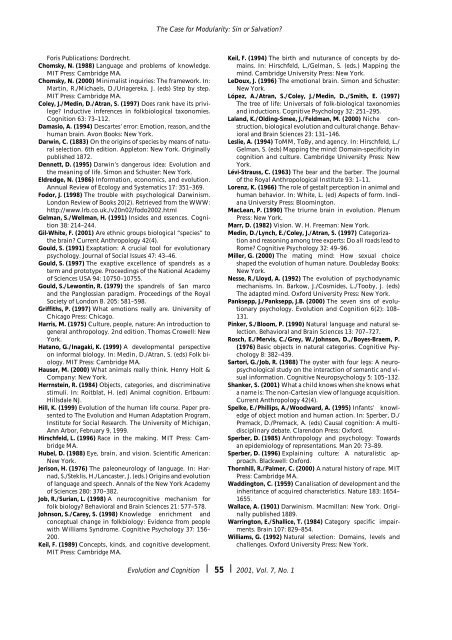The Seven Sins of Evolutionary Psychology - Konrad Lorenz Institute
The Seven Sins of Evolutionary Psychology - Konrad Lorenz Institute
The Seven Sins of Evolutionary Psychology - Konrad Lorenz Institute
You also want an ePaper? Increase the reach of your titles
YUMPU automatically turns print PDFs into web optimized ePapers that Google loves.
<strong>The</strong> Case for Modularity: Sin or Salvation?Foris Publications: Dordrecht.Chomsky, N. (1988) Language and problems <strong>of</strong> knowledge.MIT Press: Cambridge MA.Chomsky, N. (2000) Minimalist inquiries: <strong>The</strong> framework. In:Martin, R./Michaels, D./Uriagereka, J. (eds) Step by step.MIT Press: Cambridge MA.Coley, J./Medin, D./Atran, S. (1997) Does rank have its privilege?Inductive inferences in folkbiological taxonomies.Cognition 63: 73–112.Damasio, A. (1994) Descartes’ error: Emotion, reason, and thehuman brain. Avon Books: New York.Darwin, C. (1883) On the origins <strong>of</strong> species by means <strong>of</strong> naturalselection. 6th edition. Appleton: New York. Originallypublished 1872.Dennett, D. (1995) Darwin’s dangerous idea: Evolution andthe meaning <strong>of</strong> life. Simon and Schuster: New York.Eldredge, N. (1986) Information, economics, and evolution.Annual Review <strong>of</strong> Ecology and Systematics 17: 351–369.Fodor, J. (1998) <strong>The</strong> trouble with psychological Darwinism.London Review <strong>of</strong> Books 20(2). Retrieved from the WWW:http://www.lrb.co.uk./v20n02/fodo2002.htmlGelman, S./Wellman, H. (1991) Insides and essences. Cognition38: 214–244.Gil-White, F. (2001) Are ethnic groups biological “species” tothe brain? Current Anthropology 42(4).Gould, S. (1991) Exaptation: A crucial tool for evolutionarypsychology. Journal <strong>of</strong> Social Issues 47: 43–46.Gould, S. (1997) <strong>The</strong> exaptive excellence <strong>of</strong> spandrels as aterm and prototype. Proceedings <strong>of</strong> the National Academy<strong>of</strong> Sciences USA 94: 10750–10755.Gould, S./Lewontin, R. (1979) the spandrels <strong>of</strong> San marcoand the Panglossian paradigm. Proceedings <strong>of</strong> the RoyalSociety <strong>of</strong> London B. 205: 581–598.Griffiths, P. (1997) What emotions really are. University <strong>of</strong>Chicago Press: Chicago.Harris, M. (1975) Culture, people, nature: An introduction togeneral anthropology. 2nd edition. Thomas Crowell: NewYork.Hatano, G./Inagaki, K. (1999) A developmental perspectiveon informal biology. In: Medin, D./Atran, S. (eds) Folk biology.MIT Press: Cambridge MA.Hauser, M. (2000) What animals really think. Henry Holt &Company: New York.Herrnstein, R. (1984) Objects, categories, and discriminativestimuli. In: Roitblat, H. (ed) Animal cognition. Erlbaum:Hillsdale NJ.Hill, K. (1999) Evolution <strong>of</strong> the human life course. Paper presentedto <strong>The</strong> Evolution and Human Adaptation Program,<strong>Institute</strong> for Social Research. <strong>The</strong> University <strong>of</strong> Michigan,Ann Arbor, February 9, 1999.Hirschfeld, L. (1996) Race in the making. MIT Press: CambridgeMA.Hubel, D. (1988) Eye, brain, and vision. Scientific American:New York.Jerison, H. (1976) <strong>The</strong> paleoneurology <strong>of</strong> language. In: Harnad,S./Steklis, H./Lancaster, J. (eds.) Origins and evolution<strong>of</strong> language and speech. Annals <strong>of</strong> the New York Academy<strong>of</strong> Sciences 280: 370–382.Job, R./Surian, L. (1998) A neurocognitive mechanism forfolk biology? Behavioral and Brain Sciences 21: 577–578.Johnson, S./Carey, S. (1998) Knowledge enrichment andconceptual change in folkbiology: Evidence from peoplewith Williams Syndrome. Cognitive <strong>Psychology</strong> 37: 156–200.Keil, F. (1989) Concepts, kinds, and cognitive development.MIT Press: Cambridge MA.Keil, F. (1994) <strong>The</strong> birth and nuturance <strong>of</strong> concepts by domains.In: Hirschfeld, L./Gelman, S. (eds.) Mapping themind. Cambridge University Press: New York.LeDoux, J. (1996) <strong>The</strong> emotional brain. Simon and Schuster:New York.López, A./Atran, S./Coley, J./Medin, D.,/Smith, E. (1997)<strong>The</strong> tree <strong>of</strong> life: Universals <strong>of</strong> folk-biological taxonomiesand inductions. Cognitive <strong>Psychology</strong> 32: 251–295.Laland, K./Olding-Smee, J./Feldman, M. (2000) Niche construction,biological evolution and cultural change. Behavioraland Brain Sciences 23: 131–146.Leslie, A. (1994) ToMM, ToBy, and agency. In: Hirschfeld, L./Gelman, S. (eds) Mapping the mind: Domain-specificity incognition and culture. Cambridge University Press: NewYork.Lévi-Strauss, C. (1963) <strong>The</strong> bear and the barber. <strong>The</strong> Journal<strong>of</strong> the Royal Anthropological <strong>Institute</strong> 93: 1–11.<strong>Lorenz</strong>, K. (1966) <strong>The</strong> role <strong>of</strong> gestalt perception in animal andhuman behavior. In: White, L. (ed) Aspects <strong>of</strong> form. IndianaUniversity Press: Bloomington.MacLean, P. (1990) <strong>The</strong> triurne brain in evolution. PlenumPress: New York.Marr, D. (1982) Vision. W. H. Freeman: New York.Medin, D./Lynch, E./Coley, J./Atran, S. (1997) Categorizationand reasoning among tree experts: Do all roads lead toRome? Cognitive <strong>Psychology</strong> 32: 49–96.Miller, G. (2000) <strong>The</strong> mating mind: How sexual choiceshaped the evolution <strong>of</strong> human nature. Doubleday Books:New York.Nesse, R./Lloyd, A. (1992) <strong>The</strong> evolution <strong>of</strong> psychodynamicmechanisms. In. Barkow, J./Cosmides, L./Tooby, J. (eds)<strong>The</strong> adapted mind. Oxford University Press: New York.Panksepp, J./Panksepp, J.B. (2000) <strong>The</strong> seven sins <strong>of</strong> evolutionarypsychology. Evolution and Cognition 6(2): 108–131.Pinker, S./Bloom, P. (1990) Natural language and natural selection.Behavioral and Brain Sciences 13: 707–727.Rosch, E./Mervis, C./Grey, W./Johnson, D.,/Boyes-Braem, P.(1976) Basic objects in natural categories. Cognitive <strong>Psychology</strong>8: 382–439.Sartori, G./Job, R. (1988) <strong>The</strong> oyster with four legs: A neuropsychologicalstudy on the interaction <strong>of</strong> semantic and visualinformation. Cognitive Neuropsychology 5: 105–132.Shanker, S. (2001) What a child knows when she knows whata name is: <strong>The</strong> non-Cartesian view <strong>of</strong> language acquisition.Current Anthropology 42(4).Spelke, E./Phillips, A./Woodward, A. (1995) Infants’ knowledge<strong>of</strong> object motion and human action. In: Sperber, D./Premack, D./Premack, A. (eds) Causal cognition: A multidisciplinarydebate. Clarendon Press: Oxford.Sperber, D. (1985) Anthropology and psychology: Towardsan epidemiology <strong>of</strong> representations. Man 20: 73–89.Sperber, D. (1996) Explaining culture: A naturalistic approach.Blackwell: Oxford.Thornhill, R./Palmer, C. (2000) A natural history <strong>of</strong> rape. MITPress: Cambridge MA.Waddington, C. (1959) Canalisation <strong>of</strong> development and theinheritance <strong>of</strong> acquired characteristics. Nature 183: 1654–1655.Wallace, A. (1901) Darwinism. Macmillan: New York. Originallypublished 1889.Warrington, E./Shallice, T. (1984) Category specific impairments.Brain 107: 829–854.Williams, G. (1992) Natural selection: Domains, levels andchallenges. Oxford University Press: New York.Evolution and Cognition ❘ 55 ❘ 2001, Vol. 7, No. 1








